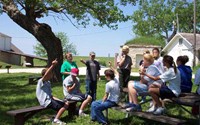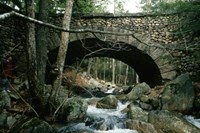- Lesson Plan (100)
- Field Trips (36)
- Distance Learning (28)
- Student Activities (12)
- Teacher Reference Materials (5)
- Other Education Materials (4)
- Traveling Trunk (4)
- Field Schools & Institutes (3)
- Guest Speakers (3)
- Media for Loan (2)
- Teacher Workshops & Other Programs (2)
- Science Labs (1)
- Science (147)
- Social Studies (86)
- Literacy and Language Arts (36)
- Math (27)
Showing 192 results for environmental engineering ...
Engineering a Better Future Virtual Field Trip
- Type: Distance Learning
- Grade Levels: Upper Elementary: Third Grade through Fifth Grade

Crushed fingers, broken legs, cuts and bruises … these were just some of the injuries suffered by 19th-century mill workers as they operated large, dangerous machines. Students will examine the Boott Cotton Mills’ looms and apply the engineering design process to identify safety problems and propose possible solutions. Using breakout groups and collaboration technology, students will design a safer loom by applying modern solutions to a historical problem.
- Type: Lesson Plan
- Grade Levels: Middle School: Sixth Grade through Eighth Grade
Going-to-the-Sun Road: A Model of Landscape Engineering - A Teaching with Historic Places Lesson Plan
- Type: Lesson Plan
- Grade Levels: High School: Ninth Grade through Twelfth Grade

Using the Going-to-the-Sun Road in Glacier National Park in Montana, this lesson plan allows students to identify problems encouraged in designing and building Going-to-the-Sun road and analyze the role of Frank A. Kittredge in planning the road. Students will use historic maps, readings, photographs and drawings to describe and evaluate arguments for building roads to provide access to Glacier National Park and other backcountry and wilderness regions.
Adapting to an Extreme Environment
LBJ and the Environment of the 1960s
"Create a Community" Environment: 4-6th Grade
"What's So Special?" Environment: 4-6 Grade
- Type: Lesson Plan
- Grade Levels: Upper Elementary: Third Grade through Fifth Grade

Students will draw a favorite plant, animal, or activity common to the Everglades environment and explain, in writing, the reason they chose it. This will help students recognize and identify one valuable aspect of a national park’s environment, and draw conclusions as to why they value that aspect of the environment.
"Incredible Shrinking Habitat" Environment: 4-6 Grade
- Type: Lesson Plan
- Grade Levels: Upper Elementary: Third Grade through Fifth Grade

The Florida panther has succumbed to numerous pressures, including loss of habitat, to become a highly endangered species. Access into wilderness areas by road building for drainage canals, and increased development for ranching, lumber, agriculture, mining, oil and gas drilling, housing and recreation all impact the panther habitat. Students will become panthers, deer and vehicles in an active tag-like game to learn about the impact of development.
Building Stewardship Through Science - Mercury in Our Environment
- Type: Field Trips
- Grade Levels: High School: Ninth Grade through Twelfth Grade

By working with various partners, including Dartmouth College's Toxic Metals Research Program, students determine mercury levels in macroinvertebrates taken from the Pogue (pond) in Marsh-Billings-Rockefeller NHP. Students learn how mercury moves through air, water, and through the food chain. By reading Marsh, learning about Billings and Rockefeller, students will cultivate a sense of stewardship and reflect on their own choices.
Environmental Prairie Science
Enviro Musical Chairs
- Type: Lesson Plan
- Grade Levels: Middle School: Sixth Grade through Eighth Grade

There's a certain mystique about the word “biodiversity” that seems to be associated with images of steamy jungles or wondrous new medicines, but the word more specifically refers to the number of species or 'species richness' of an area. One reason why tropical areas are so fascinating is that they contain the highest numbers of plant and animal species found anywhere on earth.American Samoa sits squarely in the tropics, so we should have a high biological diversity here, but we do and we don't
LBJ's Environmental Legacy
- Type: Lesson Plan
- Grade Levels: Middle School: Sixth Grade through Eighth Grade
Begin to build in LBJ's environmental legacy into your curriculum by using resources provided
"Where Have You Gone?" Environment: 4-6 Grade
- Type: Student Activities
- Grade Levels: Upper Elementary: Third Grade through Fifth Grade
Students will be able to: a) discuss some of the problems that wild animals and plants face from humans, b) list examples of how personal feelings and beliefs can affect situations involving wild organisms, and c) make decisions about a value-related plant/animal issue.
Klondike's Environmental Impact on People
- Type: Lesson Plan
- Grade Levels: Upper Elementary: Third Grade through Fifth Grade
What situations were travelers to the Klondike Gold Rush prepared to handle? Are there any bugs or animals that could have caused them harm? Do you think the small chance of finding gold successfully outweighed the risks and costs of sailing and hiking into the Yukon?
FDR’s New Deal Environmental Preservation
- Type: Lesson Plan
- Grade Levels: High School: Ninth Grade through Twelfth Grade
Students will be able to argue by using multiple sources the effectiveness of FDR’s Relief, Recovery and Reform Programs toward environmental preservation.
- Type: Lesson Plan
- Grade Levels: Middle School: Sixth Grade through Eighth Grade
Mars Traveling Trunk
- Type: Traveling Trunk
- Grade Levels: Upper Elementary: Third Grade through Fifth Grade
Journey through time and space, through the geography and geology of sand dunes, and the feats of engineering that make such exploration possible.
Protecting the Water
- Type: Field Trips
- Grade Levels: Middle School: Sixth Grade through Eighth Grade

This program explores the ways that Hot Springs National Park protects the natural water cycle and harnesses the water for human use. Students will explore different challenges from habitat protection to engineering that the park faces in protecting the 143-degree thermal water for public use. Designed for 5th and 6th grade Earth Science and Engineering. Advanced programs may be used for High School programs.








